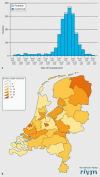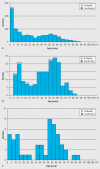The 2009 influenza A (H1N1) pandemic. Management and vaccination strategies in The Netherlands
- PMID: 23275958
- PMCID: PMC7079869
- DOI: 10.1007/s00103-012-1582-4
The 2009 influenza A (H1N1) pandemic. Management and vaccination strategies in The Netherlands
Abstract
Prior to 2009, The Netherlands had prepared itself extensively for a potential pandemic. Multidisciplinary guidelines had been drafted to control transmission and limit adverse outcomes for both a phase of early incidental introduction and for a phase with widespread transmission. The Ministry of Health had ensured a supply and distribution schedule for antivirals and negotiated a contract for vaccine purchases. During the pandemic, existing surveillance was expanded, the established infectious disease response structure was activated, and the previously prepared protocols for communication, diagnostics, use of antivirals, and vaccination implementation were operationalized and implemented. When the pandemic turned out to be less severe than many had anticipated, risk communication and rapid modification of guidelines and communication became a major challenge. Antivirals and pandemic vaccines were reserved for those at high risk for severe outcomes only. Overall, the impact of the pandemic was comparable to the impact of an average seasonal influenza epidemic, but with a shift in (severe) outcomes from the very young and elderly toward young adults. Established prepared protocols enabled timely coordinated responses. In preparing for the worst, sufficient attention must be given to preparing for a mild scenario as well.
Vor 2009 hatten sich die Niederlande ausführlich auf eine potenzielle Pandemie vorbereitet. Zur Kontrolle der Übertragung und Begrenzung ungünstiger Verläufe waren sowohl für eine Frühphase der anfänglichen Einschleppung als auch für eine Phase weitverbreiteter Übertragung multidisziplinäre Leitlinien erstellt worden. Das Ministerium hatte einen Versorgungs- und Verteilungsplan für antivirale Substanzen erstellt und über einen Vertrag zum Kauf von Impfstoffen verhandelt. Während der Pandemie wurde die bestehende Überwachung ausgeweitet, das etablierte Reaktionsverfahren für Infektionskrankheiten aktiviert und die zuvor erstellten Protokolle für Kommunikation, Diagnostik, Einsatz antiviraler Substanzen und Impfdurchführung wurden ein- und umgesetzt.
Als sich herausstellte, dass die Pandemie nicht so schwer wie befürchtet war, wurden die Risikokommunikation sowie die schnelle Modifizierung der Leitlinien und ihre Kommunikation zur wesentlichen Herausforderung. Antivirale Substanzen und Pandemieimpfstoffe waren nur für Personen reserviert, bei denen ein hohes Risiko für eine schwere Erkrankung bestand. Insgesamt waren die Auswirkungen der Pandemie vergleichbar mit denen einer durchschnittlichen saisonalen Influenzaepidemie, allerdings mit einer Verlagerung von (schweren) Erkrankungen von den ganz Jungen und Älteren zu jungen Erwachsenen. Etablierte vorbereitete Protokolle ermöglichten zeitlich koordinierte Reaktionen. Bei der Vorbereitung auf das Schlimmste muss auch der Einstellung auf ein weniger dramatisches Szenario ausreichende Aufmerksamkeit geschenkt werden.
Figures



Similar articles
-
Pandemic vaccination strategies and influenza severe outcomes during the influenza A(H1N1)pdm09 pandemic and the post-pandemic influenza season: the Nordic experience.Euro Surveill. 2016 Apr 21;21(16). doi: 10.2807/1560-7917.ES.2016.21.16.30208. Euro Surveill. 2016. PMID: 27123691
-
[Pandemic preparedness planning. What did we learn from the influenza pandemic (H1N1) 2009?].Bundesgesundheitsblatt Gesundheitsforschung Gesundheitsschutz. 2010 Dec;53(12):1277-82. doi: 10.1007/s00103-010-1162-4. Bundesgesundheitsblatt Gesundheitsforschung Gesundheitsschutz. 2010. PMID: 21161478 German.
-
Low adherence to influenza vaccination campaigns: is the H1N1 virus pandemic to be blamed?Ital J Pediatr. 2011 Nov 10;37:54. doi: 10.1186/1824-7288-37-54. Ital J Pediatr. 2011. PMID: 22074674 Free PMC article.
-
Uptake of pandemic influenza (H1N1)-2009 vaccines in Brazil, 2010.Vaccine. 2012 Jul 6;30(32):4744-51. doi: 10.1016/j.vaccine.2012.05.007. Epub 2012 May 18. Vaccine. 2012. PMID: 22609010 Review.
-
Vaccination against influenza: role and limitations in pandemic intervention plans.Expert Rev Vaccines. 2012 Aug;11(8):1009-19. doi: 10.1586/erv.12.63. Expert Rev Vaccines. 2012. PMID: 23002981 Review.
Cited by
-
Immunogenicity of Influenza Vaccines: Evidence for Differential Effect of Secondary Vaccination on Humoral and Cellular Immunity.Front Immunol. 2019 Jan 29;9:3103. doi: 10.3389/fimmu.2018.03103. eCollection 2018. Front Immunol. 2019. PMID: 30761157 Free PMC article. Clinical Trial.
References
MeSH terms
Substances
LinkOut - more resources
Full Text Sources
Medical

